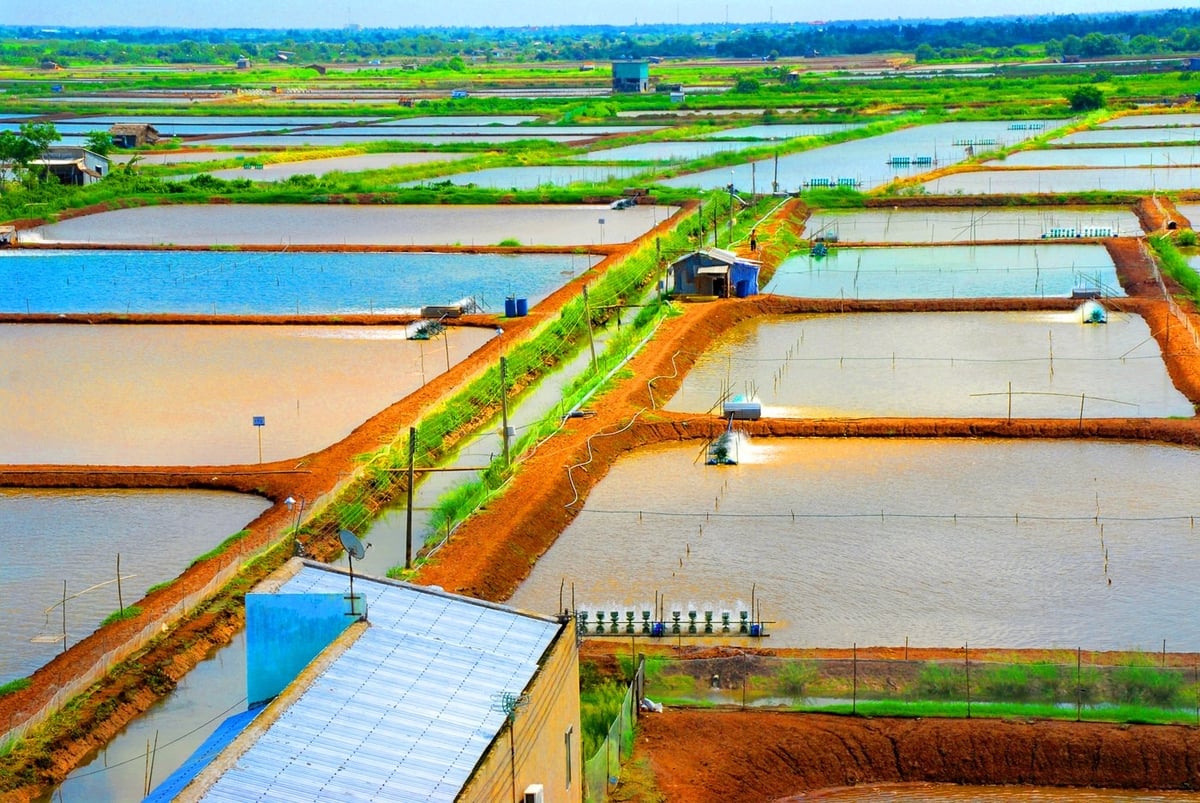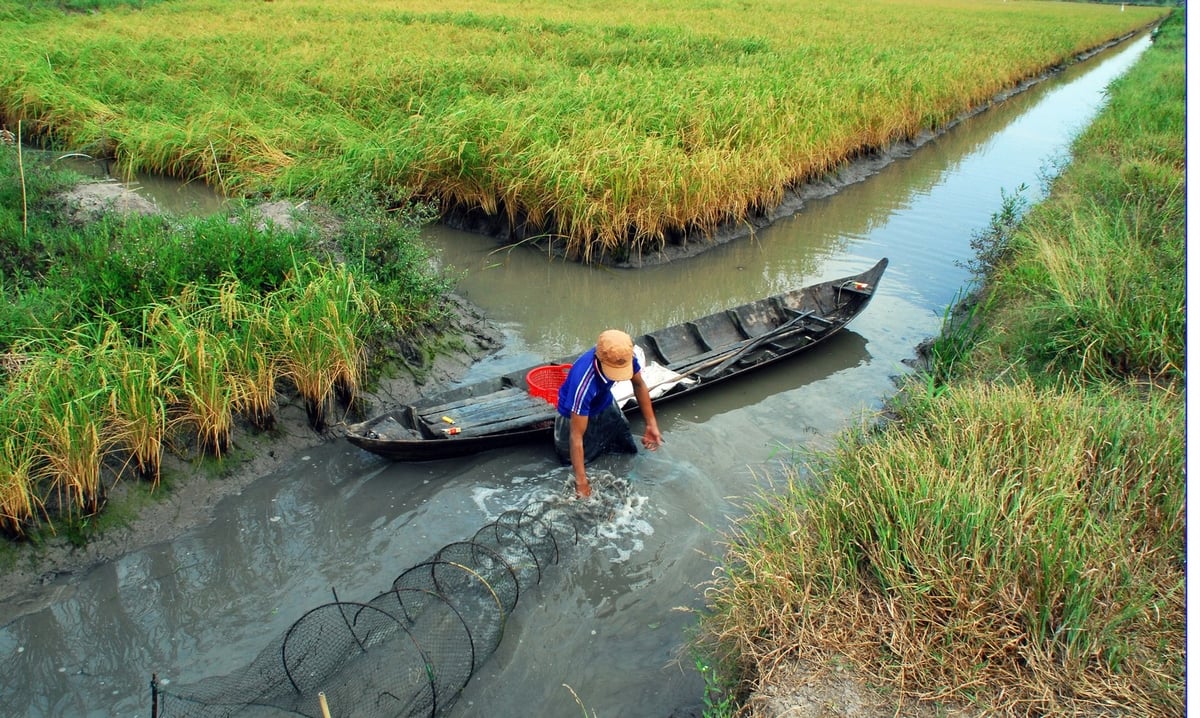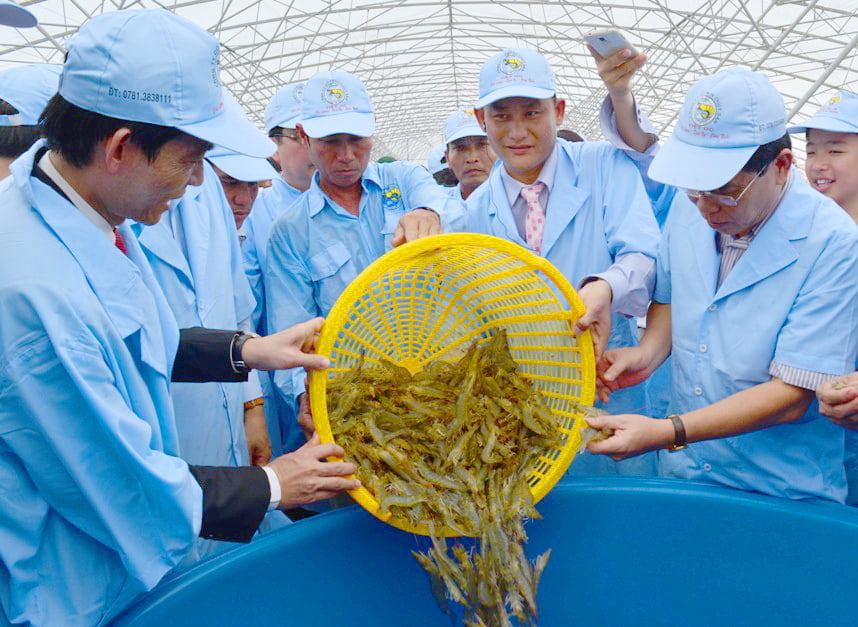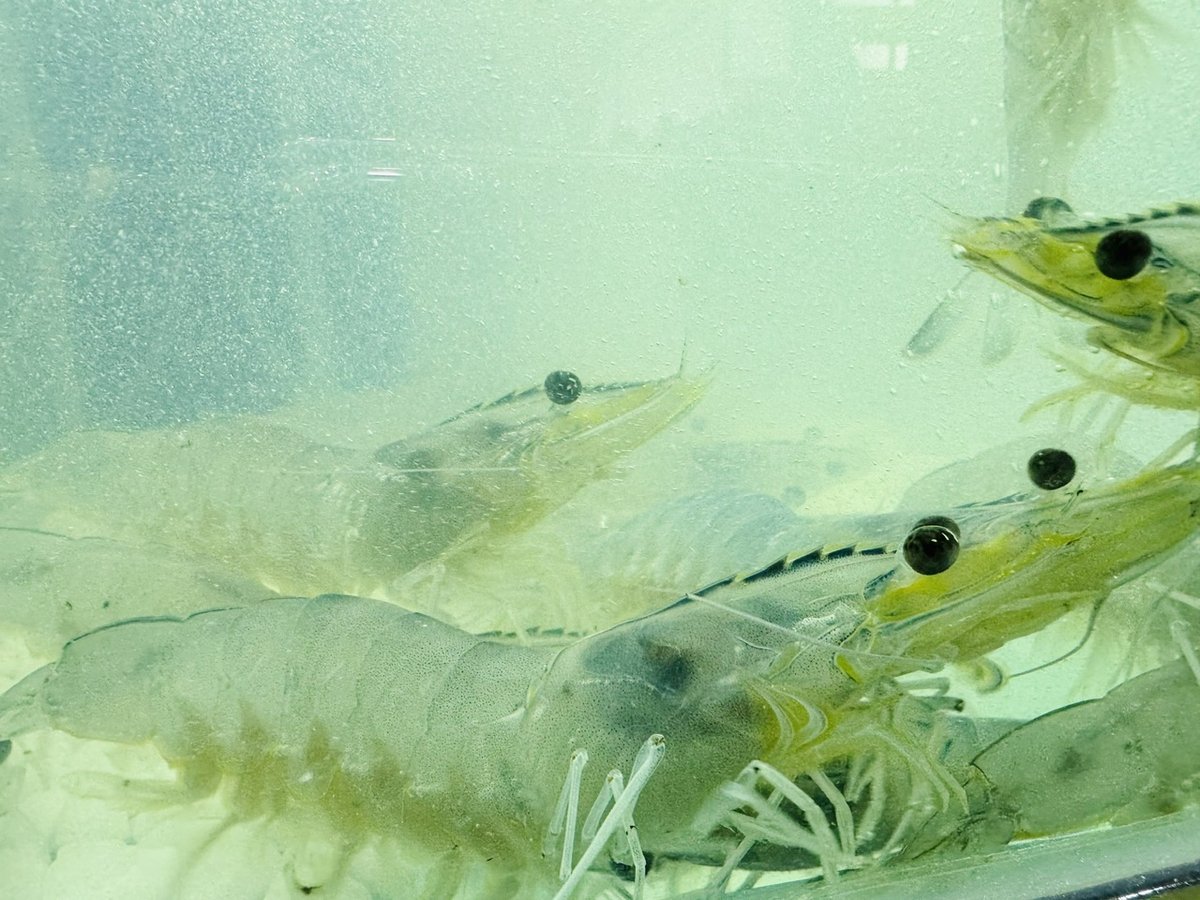May 28, 2025 | 20:25 GMT +7
May 28, 2025 | 20:25 GMT +7
Hotline: 0913.378.918
May 28, 2025 | 20:25 GMT +7
Hotline: 0913.378.918

In 2024, the area for brackish water shrimp farming reached 737,000 hectares with a production of 1.264 million tons, an increase of 5.3% compared to the previous year. Brackish water shrimp exports brought in 3.856 billion USD, up by 14%. Photo: Le Hoang Vu.
The Directorate of Fisheries (Ministry of Agriculture and Environment) recently worked together with the organizing committee of the Vietshrimp Aquaculture International Fair 2025 (VietShrimp 2025) to hold a workshop on the green transformation of the Vietnamese shrimp industry.
According to the Directorate of Fisheries, the shrimp industry has played a vital role in the country's seafood exports for the past two decades. Each year, shrimp accounts for approximately 40-45% of the total value of seafood exports, equivalent to about 3.5-4 billion USD.
The rapid growth of aquaculture has not only boosted the economy but also created millions of jobs and improved the livelihoods of farmers. Over the years, the government has shown a strong commitment to supporting the industry, introducing a range of policies aimed at promoting sustainable development through green and clean practices. One of the key milestones was in 2022, when the Prime Minister approved the Environmental Protection Project in Fisheries Activities for the period 2021-2030, focusing on eco-friendly and sustainable practices in shrimp farming.
One of the key objectives set out is to enhance the capacity to adapt to climate change, reduce greenhouse gas emissions, and build and develop circular economy and green economy models in fisheries activities.
According to experts, the green transition in the seafood industry has three core goals: expanding sustainable aquaculture models, effectively managing all fisheries, and upgrading value chains in the aquaculture feed system.
The shift towards green and circular production is also a growing trend among many enterprises in the seafood industry. This move towards more sustainable practices, such as reducing greenhouse gas emissions in aquaculture and seafood processing, helps businesses ensure they meet the environmental standards required for international certifications.

The application of environmentally-friendly shrimp farming models not only helps increase export value but also contributes to protecting the ecosystem. Photo: Le Hoang Vu.
In the context of Vietnam's seafood industry moving toward sustainable development, Mr. Tran Dinh Luan, the Director of the Directorate of Fisheries (Ministry of Agriculture and Environment), emphasized the critical role of green development in the brackish water shrimp production chain. He explained that adopting environmentally friendly shrimp farming models not only boosts export value but also plays a key role in protecting the ecosystem and ensuring long-term livelihoods for shrimp farmers.
In 2024, the area dedicated to brackish water shrimp farming reached 737,000 hectares, with a total production of 1.264 million tons, marking a 5.3% increase compared to the previous year. This growth was mirrored in the export sector, with brackish water shrimp exports generating 3.856 billion USD, reflecting a 14% rise and highlighting the strong potential for continued development in Vietnam’s shrimp industry.
Mr. Tran Dinh Luan pointed out that green development is an inevitable trend for improving the competitiveness of Vietnamese shrimp in the global market. The application of advanced technologies such as Biofloc, Micro-Nano Bubble Oxygen, and two-stage farming processes has proven to be highly effective in optimizing nutrition while reducing environmental pollution.
Another key focus is disease control and ensuring food safety. This means reducing the reliance on antibiotics and instead, strengthening the use of biological products for environmental management. Furthermore, the recycling of by-products from the shrimp industry—such as shrimp shells and waste sludge—into valuable products like chitin, chitosan, peptides, and organic fertilizers is encouraged.
“Green development is not just a trend; it is a prerequisite for the Vietnamese shrimp industry to maintain its position in the global market. Through the application of advanced technologies, effective disease management, and the promotion of a circular economy, Vietnam's brackish water shrimp industry will not only grow in terms of production but also move toward a safe, efficient, and sustainable production model", affirmed Mr. Tran Dinh Luan.

The shift towards green development and circular production is a trend embraced by many enterprises in the seafood industry to better comply with environmental regulations, laws, and standards. Photo: Le Hoang Vu.
According to Mr. Ngô Xuân Nam, Deputy Director of the SPS Vietnam Office (Ministry of Agriculture and Environment), the Vietnamese shrimp industry will face numerous challenges in 2025, particularly due to the increasingly stringent requirements from international markets.
Key markets such as the EU, the US, Japan, and China are progressively tightening their regulations concerning food safety, traceability, and control of antibiotic residues. These regulations require shrimp export businesses to make significant investments in farming processes, processing techniques, and quality control measures. Without compliance with these strict standards, the risk of facing import bans or high tariffs is substantial.
Furthermore, the rising trend of sustainable consumption is prompting importers to prioritize products with ecological certifications such as ASC (Aquaculture Stewardship Council) or GlobalGAP. As a result, the Vietnamese shrimp industry must shift towards greener production models that reduce environmental impact. Adopting green practices is crucial for maintaining the industry's competitiveness on the international stage.
In 2025, Vietnam will also continue to uphold its commitments under various free trade agreements (FTAs) like the EVFTA and CPTPP. These agreements not only open up opportunities to access international markets but also impose rigorous standards related to labor practices, environmental protection, and product quality.
Additionally, the US market is tightening its regulations on anti-dumping measures and countervailing duties on imported shrimp. As a result, businesses will need to develop long-term strategies focused on transparency in production, operations, and compliance with international trade laws to mitigate the risks of legal challenges.

Green development is not only a trend but also a prerequisite for the Vietnamese shrimp industry to maintain its position in the global market. Photo: Le Hoang Vu.
To overcome these challenges, Mr. Ngo Xuan Nam emphasized that the Vietnamese shrimp industry needs to focus on a set of strategic solutions, including: promoting high-tech shrimp farming; enhancing the collaboration between farmers, processing businesses, and exporters; encouraging ecological shrimp farming models, such as mangrove shrimp farming; strictly controlling the use of antibiotics and chemicals in aquaculture; and ensuring transparent and traceable sourcing of shrimp products.
With proper preparation and a clear, well-thought-out strategy, Vietnam's shrimp industry has the potential to maintain its standing in the global market, fully capitalizing on opportunities from free trade agreements and the growing trend toward sustainable consumption.
According to Mr. Phung Duc Tien, Deputy Minister of Agriculture and Environment, the shrimp industry is entering a transformative phase, characterized by a green revolution in production practices. Many companies are already proactively investing in eco-friendly shrimp farming technologies that minimize environmental impact. These technologies not only help meet the rigorous standards required by international markets but also allow companies to achieve prestigious certifications like ASC, GlobalGAP and BAP.
In addition, the use of shrimp feed has been and continues to be improved to reduce carbon emissions and increase environmental friendliness.
The goal of the shrimp industry is no longer limited to increasing production volume alone; it is now equally focused on enhancing product quality, ensuring consumer health and safety, and creating sustainable value-added products. This is the key for Vietnamese shrimp to continue affirming its position in the global market.
Translated by Phuong Linh

(VAN) FAO’s Director-General addresses the 5th Baghdad International Water Conference.
/2025/05/26/1716-4-nongnghiep-191706.jpg)
(VAN) Chain linkages, technological innovation, and raw material zoning are three strategic pillars for the coconut industry to strongly develop and elevate its position on the global agricultural map.
![Advanced mariculture – an inevitable trend: [4] Accompanied by scientists](https://t.ex-cdn.com/nongnghiepmoitruong.vn/608w/files/sohk/2025/05/13/1941-pgsts-vo-van-nha-140958_717.jpg)
(VAN) According to Assoc. Prof. Dr. Vo Van Nha, Director of the RIA III, the development of advanced offshore mariculture is no longer an option but an essential path for Vietnam’s fisheries sector.

(VAN) Vietnam is intensifying the development of mollusk farming areas that meet international standards, aiming for sustainable growth and enhancing its export position in the global seafood market.
![Advanced mariculture – an inevitable trend: [3] Policy-driven momentum](https://t.ex-cdn.com/nongnghiepmoitruong.vn/608w/files/doanhtq/2025/05/21/0104-0616-0348-nuoi-bien-170339_789.jpg)
(VAN) To ensure the success of offshore mariculture that uses advanced technologies, it is essential to establish supportive policies that inspire both individuals and enterprises to invest with confidence.
![Advanced mariculture – an inevitable trend: [2] Outstanding results](https://t.ex-cdn.com/nongnghiepmoitruong.vn/608w/files/sohk/2025/05/12/4632-4136-nuoi-bien-11-164117_819.jpg)
(VAN) Pilot models of high-tech offshore mariculture in Vietnam, particularly in the South Central Coast region, have demonstrated exceptional economic returns and sustainability, setting a new direction for the country’s aquaculture industry.
![Advanced mariculture – an inevitable trend: [1] Moving offshore](https://t.ex-cdn.com/nongnghiepmoitruong.vn/608w/files/phucpm/2025/05/18/0252-2436-nuoi-bien-6-162148_783.jpg)
(VAN) Mariculture using advanced technology and moving offshore is an inevitable trend, as nearshore areas increasingly reveal limitations.